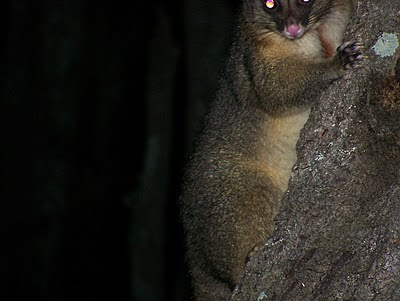It was about 26 inches long. It looked like a catfish: you can clearly see the barbels around the mouth. I never knew there were saltwater catfish, but hey, what do I know?
Much, much weirder: The head looked like a catfish, but it had one long fin that went from its back, around its pointy tail, to its belly—like an eel. That's weird. Was it an eel? Was it a catfish? Was I hallucinating?
Here's a good shot of the tail. (Click on pic to enlarge.) The pink spots are where the fish had been chewed on by something.
Christine and I did some googling when we got home. After that we did some research. (Ba dum.) We found the Cobbler fish, or Eel-tail catfish:
Cnidoglanis macrocephalusYou can actually see the fifth set of barbels, up there on top of is head in the first pic.
The cobbler is yellow to dark brown with pale mottling over the back and sides, usually progressively darker towards the tail. It has a large flattened head and a long eel-like body that tapers to a pointed tail, with continuous dorsal, caudal and anal fins, attaining a maximum length of up to 91 centimetres. The broad mouth is surrounded by four pairs of barbells (feeler-like tentacles), with a fifth pair of barbells present above the snout...
More:
...and venomous serrated spines at the front of the pectoral and dorsal fins, which can inflict a painful wound.
I had picked that fish up before I read that. Note to self: Don't pick things up. Just don't.
A little more about those spines, and catfish in general:
All catfish, except members of Malapteruridae (electric catfish), possess a strong, hollow, bonified leading spine-like ray on their dorsal and pectoral fins. As a defense, these spines may be locked into place so that they stick outwards, which can inflict severe wounds. In several species catfish can use these fin rays to deliver a stinging protein if the fish is irritated. This venom is produced by glandular cells in the epidermal tissue covering the spines. In members of the family Plotosidae, and of the genus Heteropneustes, this protein is so strong it may hospitalize humans, those unfortunate enough to receive a sting; in Plotosus lineatus, the stings may result in death.
The Cobbler fish is, of course, from the family Plotosidae.
We can even get a look at those bony spines on our fish:
You see that white spike out its back that looks like someone stuck a plastic toothpick in him or something? That's the dorsal fin's venom delivery spine. On this shot, of the fish's underbellly, you can see one of the pectoral spikes, and you can even see the serrated edge:
Here's a closeup of the spike:
A few more picks. Full fish:
Belly, with what might be eggs poking out:
And that strange mouth. (That's top-side-up.):

















































